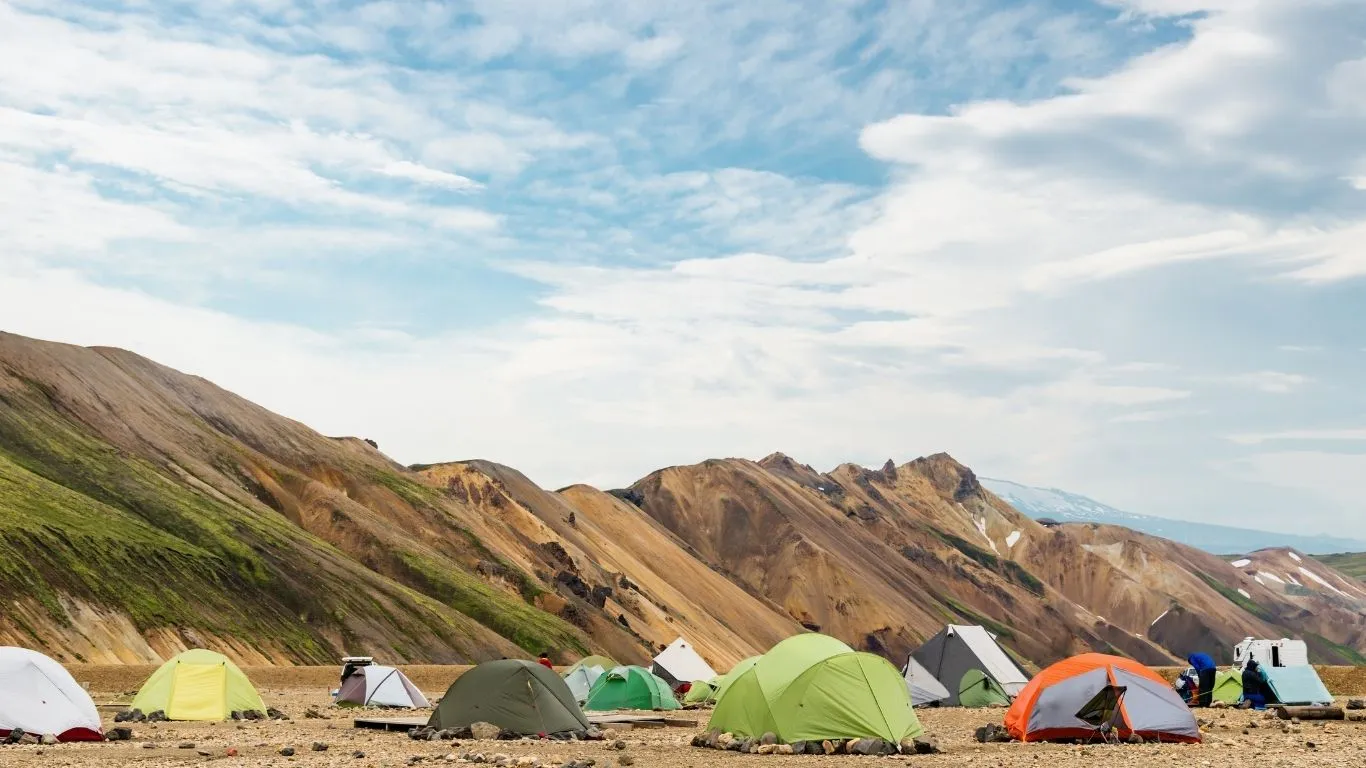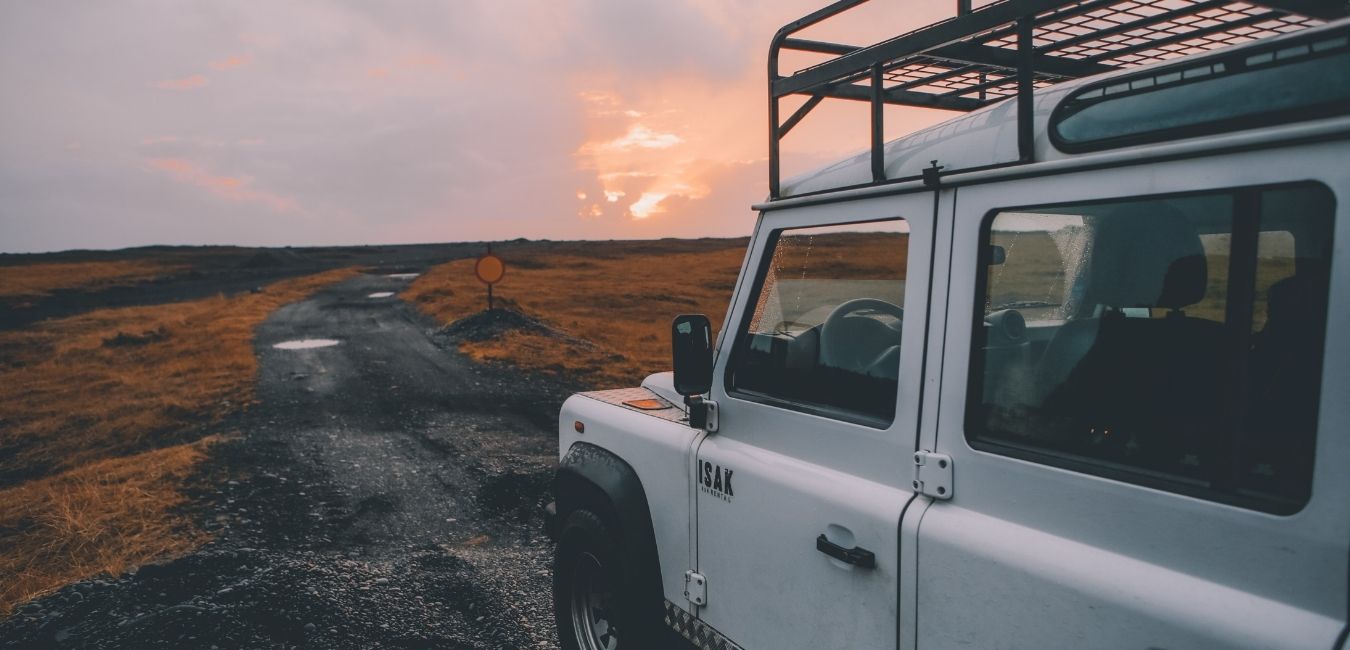Iceland camping my story – It was the end of September, we had already cycled over 2.000km in the last two months and were eating another simple out-of-the-bag meal. The wind was blowing strong and we were camping another night, trying to stay warm while we were sitting in our goose-down sleeping bags. We knew it would be freezing cold that night, which was confirmed the next morning when we woke up in a frozen tent.
I absolutely loved it! The challenges, the extremes, and expecting the unexpected. That is what you need to handle while camping in Iceland. But don’t worry! This guide will prepare you for everything you might have to face so that you survive your tent camping in Iceland trip with a happy and heart-warming feeling!


Why Iceland camping is absolutely worth it
Camping in Iceland is a national tradition. Every summer locals pack their stuff to meet friends and family on campgrounds all around the country. Besides integrating with the locals, there are 3 legitimate reasons why camping in Iceland is absolutely worth it!
1. Save costs
I can make it a long-winded story, but I prefer to keep it simple: Iceland is expensive! The chances are quite big that you already spent a large part of your budgeted money on a rental car, so why not save on accommodation costs?
Camping will cost only 10% of what a hotel will cost you. And 20% of what a guest house will cost you. So, yes, you can seriously save on accommodation costs if you decide to go camping.
2. Sustainable
Iceland is a country where nature is still pure and untouched. Locals are proud of the natural beauty of lava fields, mossy sights, lunar landscapes and glaciers. The government does the best they can to keep it this way, but tourism isn’t an easy thing to handle.
So, why not help them a bit and choose a sustainable way of living in Iceland. While camping, you use less water. Also, your room doesn’t need to be cleaned with chemicals and your bed sheets and towels don’t need to be washed after 1-time of use.
This sounds like little and small things, but small things can make a huge difference. Just make sure you camp in a sustainable way by not leaving trash, food scraps, or anything else behind. Otherwise, this reason doesn’t count anymore.
Tip: Do you want to be a responsible tourist? Take the Icelandic Pledge, a unique and online ‘oath’ for tourists, agreeing to respect Icelandic’s nature and to travel responsibly during their visit.
3. An experience like no other
Camping is another way of experiencing the exhilarating Icelandic nature. You don’t just see it, but you feel it, you smell it and you hear it. Imagine laying in your tent or car, hearing the wind that rushes past you and a waterfall that clatters down in the background. Seeing a glimpse of the Northern Lights when you stick your head outside during a clear night.
Then in the morning, you feel super fresh, waking up in the cold but oh so fresh air. Breathing in that air and smelling pure nature and absolutely nothing else (unless you are very lucky and your partner is preparing pancakes for breakfast!).
In my opinion, these are 3 absolute legitimate reasons why you should go camping in Iceland. It brings your exploration and experience of this country to a whole new level.
Related content: Best things to do Reykjavik
4 Different ways of camping in Iceland
I hear you thinking. Yeah, camping, it sounds nice, but sleeping in a tent keeps me from going! Not such a big fan of a tent? I can bring you some good news: There are other ways to go camping in Iceland!
1. Tent camping in Iceland
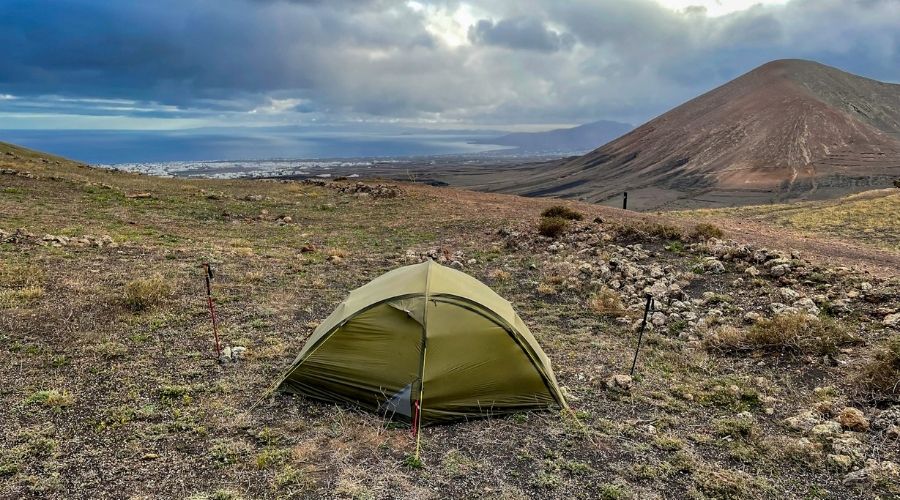
Camping in a tent is the ultimate experience. You are literally out in nature. You can feel the wind blowing through the tent, hear everything as loud as it really is and smell the fresh air.
Tent camping is the most affordable way of camping because you can rent a smaller car and campsites are cheapest if you just want to set up a tent (leave your car at the car park).
Being exposed to the elements can also have its downsides. For example when it is really wet, really cold, or really windy. But with the right equipment, that you can find in our Iceland packing list, you should be able to handle this.
2. Rooftop tent
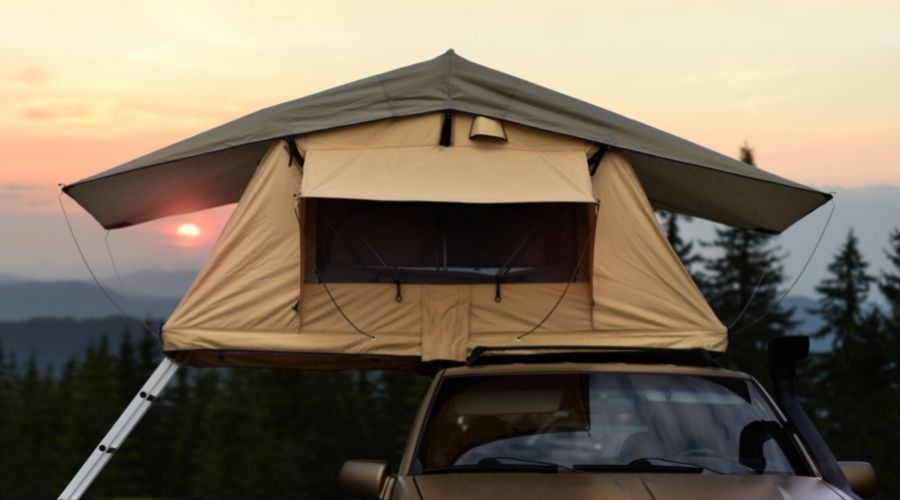
Rooftop tent camping is camping in a tent on the roof of your car. These tents are quite easy to pop up in the afternoon and to collapse in the morning.
Just like with tent camping, you are exposed to the impact of the weather, which can be either fantastic (during nights with good weather), or absolutely horrible (during nights with very bad weather if you aren’t prepared).
As the rooftop tent can only be used on the top of your car, you always have to pay for a campsite where you can park a vehicle, which is often slightly more expensive than a tent site.
3. Car


Car camping is probably the least comfortable way of camping in Iceland. It is literally camping in your car, so sleeping in your front seat with the backrest folded back as far as possible.
Although you are more protected from the weather impact, then when you stay in a tent, you can’t lay down flat. Campsites might be slightly more expensive than a tent site, but you don’t need camping equipment like a tent and sleeping mattresses.
Can I sleep in the car in Iceland?
Official it’s illegal to overnight camp in cars or any motorized vehicle outside of a designed campsite in Iceland. Unless you asked permission on the landowner.
You might also like: Car Rental Iceland: The Complete Guide
4. Camper Van

Iceland by campervan is the most luxurious version of camping in Iceland. If you rent a camper Van they are well equipped and you have all you need to make your Iceland camping adventure a success. Think of a heater, a power source for USB devices (some even come with a converter, so you can also use an actual plug), cooking equipment, extra blankets, and storage space.
Campers Iceland will cost you some more to rent, but it saves you on buying camping equipment like a tent, sleeping mattresses, sleeping bags, etc. Campsites will be the same price as a site for any other car.
When is the best time to go camping in Iceland?
Camping can be done all year round. More and more campsites are opened for visitors 12 months out of the year. That being said, you can imagine that there is no straight line to draw for the best time to go camping in Iceland. It’s up to you! Check here, for the best time to visit Iceland.
Summer Camping Iceland


Summer season runs from June until September. June and September are most likely a bit cooler, but the good thing is that it is off-season during these months. Better for your wallet and it is a lot less busy at popular spots, on the roads, at campsites, and just anywhere in Iceland.
It is a nice time to explore Iceland, the sun is out 24 hours a day from halfway thru May until the end of July. This gives you plenty of time with daylight to explore all you want to see. It is a crazy feeling being out there in the middle of the night thinking it is almost lunchtime. On the other hand, the midnight sun makes your chances to see the Northern Lights absolutely 0%. You just can’t have it all!
During summertime, you normally have the best weather you can get in Iceland with an average temperature of 13°C during the day. But the weather in Iceland is unpredictable and can change rapidly. Therefore, you always have to be prepared for cold, warm, wet, and dry circumstances! Days, when the temperatures rise to 20°C, aren’t exceptional in summer, but also be prepared to face a snowstorm.
Winter camping Iceland
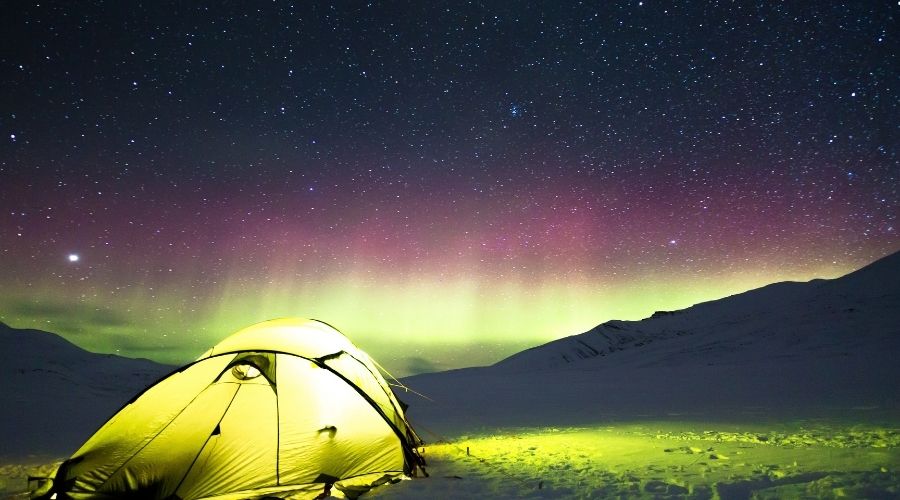
Camping in winter is another story. Winter season starts when summer is over, so it runs from October until May/June. For the location, close to the arctic, Iceland has a fairly mild winter climate. Temperatures will drop towards 0°C and during the night they drop a bit further, but that is quite doable for a winter destination, don’t you think!?
Just one thing… Be prepared for the wind! When the wind blows strong it feels freezing cold. Make sure you protect yourself to stay warm. And the wind in Iceland is really really strong.
Deeper into the winter season the days get shorter and shorter. During December and January, you will only have 4 to 5 hours of daylight. This is a very good time of the year to see the Northern Lights. Although you need a bit more than a dark sky – like a clear night and high Northern Light index! Anyway, your chances to see the Northern Lights are way bigger in winter than in summer.
You might also like: Cold weather camping: 14 hacks that will keep you warm
Best time to camp in Iceland
In short, if you can’t stand the cold or the darkness, you should visit Iceland in the summer months. Just make sure you save a little bit extra, as prices for rental cars and accommodation will go up.
If you just want to see the Northern Lights and don’t really bother to see anything else in Iceland, visit Iceland during the darkest winter months (December and January). It might be a good option to rent a camper Van instead of bringing a tent. This will protect you as much as possible from the harsh weather circumstances.
If you want to have a bit of both, visit Iceland in April, September or October. The further away from summer, the more coldness you can expect. But these months give you quite some daylight for exploration and also some dark hours to look out for the Northern Lights.
Where are you allowed to camp?
Camping used to be allowed anywhere in Iceland. Just pitch your tent, spend the night and continue your trip the next day. But rules have changed as of June 2016 (actually, it was November 2015, but these rules weren’t clear enough).
This has to do with the increasing amount of tourists visiting Iceland each year and the protection of nature. Iceland has some beautiful untouched landscapes, but it only takes one pair of footsteps for thousands to follow. So, to make sure all these tourists have as little as possible impact on nature, you can now only camp in designated areas.
This is not a simple agreement, but a governmental rule. Accept it and just don’t camp where you are not allowed to camp. Many more people like to explore Iceland after you and they would really appreciate having the same views over untouched landscapes, as you had.
Must Read: The Best Golden Circle Iceland Guide + Map
Wild camping Iceland rules


Wild camping is only left for the real adventurers among us that have the courage to defy the rough Icelandic nature on a pair of boots and a fully-packed backpack on their back. And then still, some rules apply:
- You can camp along public routes in inhabited areas, you may pitch a traditional camping tent for one night on uncultivated land, provided there is no campsite in the immediate vicinity and the landowner has not restricted or prohibited access, passage or stay within the area by means of signs on gates and walking paths.
- You can camp along public routes in uninhabited areas, you may pitch a traditional camping tent on privately owned land or national land.
- You can camp away from public routes, you may pitch a traditional camping tent, either on privately owned or national land unless otherwise indicated in special rules which may be applicable to the land area in question.
Iceland campsites map
Best campsites in Iceland
Must Read: Great Things to Do in North Iceland
Camping card Iceland
Iceland has a camping card, which you can use at 42 campsites around the country. It is valid during the camping season (beginning of June until halfway thru September) and you can use it for 28 nights. 1 card can be used for two adults and 4 children.
If you go to Iceland for at least 8 days and want to camp every night, this camping card might be a good solution for you. The camping card costs around US$175 but lodging taxes still need to be paid on-site, which is US$3 per tent/vehicle.
You can buy the camping card online and they will send it to your home address. Please check the shipping times before you order. You can also buy it upon arrival at one of the affiliated campsites. Some gas stations and tourist offices do also sell them.
Tip: Off-season the prices are lower, so if you have the change to travel outside high-season, you can save some extra costs on accommodation.
What does it cost to camp in Iceland?
Camping is your cheapest option when it comes to accommodation in Iceland. Prices among campsites vary from place to place, depending on the facilities and area where they are situated.
The cheapest campsite you will find will cost you between US$5 and US$10 per night per person. A campsite will most probably not cost you more than US$35 per night per person. A site for only a tent is cheaper than when you sleep in your vehicle. As a hiker or cyclist you can free camping in Iceland, but this is only in the rough highlands where there are no other facilities.
What facilities do Icelandic campsites have?

Camping in Iceland is very easy. There is no need to make pre-bookings, so you have the freedom to make or change plans last-minute. Many campsites are situated around the ring road. In the highlands, your choice is a little less.
Campsites will vary a lot from place to place. Some have all you need, like a kitchen, warm shower, water hose to fill up the water tank in your camper van, covered areas that give you shelter from the elements, etc. Others are only a field to pitch your tent with a tap for drinking water.
If a campsite has facilities (which most of them do), you know for sure that it is clean. Campsites are well maintained and the staff takes it as a serious job to comfort their guests.
Kitchen
When you go camping in Iceland you should always have your own cooking essentials with you, like a gas stove, pots and pans, plates and cutlery. Not all campsites in Iceland have a shared kitchen for you available and eating out in restaurants is crazy-expensive.
Shower
If you end up on a campsite without a shower, don’t worry. There are many local swimming pools and thermal baths where you can go for a small entrance fee. You can use the pools to relax and take a shower to refresh.
Iceland Campsites
Thinking of camping? You might think about cozy and private spots between the trees. In Iceland, it is something like that, except that there are barely any trees in Iceland. So, no need to bring your hammock!
There are a couple of reasons why there are so few trees left in Iceland, but the main reason is that the Vikings used a lot of wood to build their houses and boats and to use it as fuel to stay warm and for the smelting of metal.
The Icelandic government tries to re-plant trees and slowly they are coming back. But the trees that are found in Iceland are young, small and not very strong. So, even if you end up on a campground where they have trees, don’t hang your hammock!
Check out: Waterfalls in Iceland Ultimate Bucket List
Camping in iceland safety: Stick to these 4 rules and you’ll be fine!
Camping is quite safe in Iceland. Snakes won’t sneak into your tent and there are no monkeys that might steal your belongings. Even the mosquitos don’t bite, they just annoy you with their buzzing.
Still, there are some precautions you should take to make your camping adventure in Iceland a real success. Camping in Iceland safety tips:
1. Camping in Iceland what you should know about the weather


Ultimate Tip: The best weather forecast in Iceland can be found on yr.no
Although the weather is highly unpredictable, weather predictions will give you an indication of wind speeds and temperatures. Also, take volcano eruption warnings seriously. Iceland is known for its volcanic landscapes and many of them are still active.
We have been stuck for three days in our tent, holding the poles to avoid they would break. Luckily we had a very good tent that survived the storm without even a small tear, but we have seen tents torn right through the middle, leaving only people on an air mattress behind in the open air. No joke.
So, if you sleep in a tent, make sure you are able to tidy up the whole tent in the morning. If you know in advance that a strong wind comes up during the night, you might be better off booking some other kind of accommodation.
Oh, and now we are talking about wind. Make sure you hold the door of your car when you get in and out of the car. The wind in Iceland can be really strong and your door will fly away if you don’t hold it tight!
2. Prepare yourself for being stuck
Worst case scenario you are stuck in one place for a couple of days. That is not such a big deal if you are prepared for it. Always make sure you have food and drinking water for a couple of days with you.
Especially when you go into the highlands. There are no supermarkets anywhere close and campsites barely have anything to offer, as it is too remote to supply them.
All water in Iceland is safe to drink. As well as water from the taps as water from flowing glacier rivers. Bring a reusable drinking bottle with you and you are good to go!
Must Know: The Bonus supermarket is the discount supermarket in Iceland and will offer you the best prices for most products.
Related post: The Ultimate Hiking Guide Iceland
3. Do not light a fire
Another thing camping is associated with are campfires. Yet, it is another reason why camping in Iceland is different. It is absolutely forbidden to start a campfire. No matter how small.
It will be hard to start a fire anyway, as there won’t be much wood around to burn. Icelandic nature is too fragile and the wind can rise unexpectedly and take sparks everywhere. The consequences of this can simply not be foreseen.
4. Bring a SPOT
If you really want to have a safe feeling, you should bring a SPOT on every adventure. This is a GPS tracker with an S.O.S. button. If you are in real danger, you can hit the button (which is hidden underneath a safety cap). The local emergencies will be informed and if they can’t get you, a rescue team will come over.
Useful tipes for camping in Iceland
In the meanwhile, pretty much everything about camping in Iceland is covered, but there is one very important thing I didn’t mention yet. Or maybe I did, but I just want to give it some extra attention.
Iceland is one of the fewer places on earth where nature is so pure and so untouched. Let us all keep it that way. NO EXCEPTIONS!
Please people, and I can’t emphasize this enough, don’t leave anything behind! No toilet paper, no food scraps, no price tags from souvenirs, and when it comes to Iceland: even footprints should not be left (in untouched nature).
Here are some more things you have to do, to have as little as possible impact on the Icelandic nature:
- Show respect regarding private property. Do not trespass if there is a sign “no trespassing” and do not camp when there is a sign “no camping”
- Respect the vegetation. Do not drive off-road and do not hike or bike off-trail. These fragile ecosystems can be ruined in a second and it takes ages to let it grow back.
- Respect the animals: Watch out for sheep and wild horses. These animals can graze freely in nature, which is a beautiful fact. Let’s take care of them so they can stay free!
Iceland shelters


Must Know: When you are camping in Iceland and the weather is really really bad, you will find shelters next to the road. You can use them to keep warm and have a good sleep. Keep in mind, this is just for emergencies, so please don’t use them for saving money!
What to pack for a happy camping adventure in Iceland?
Some things are essential to make your camping adventure in Iceland nothing else than a lot of fun. Other things you can pack optional, but might make it a better experience!
Essentials
- Warm clothes and multiple layers
- A wind and waterproof jacket
- Rain clothes
- If you are sleeping in a tent: a very waterproof and windproof tent
- Also, bring extra stakes for your tent!
- Cooking equipment (gas stove, lighter, pots and pans, plates, mugs and cutlery)
- Warm sleeping bag (goose-down sleeping bags are the best!)
- For tent camping: Sleeping mattress and possibly a travel pillow
- Wet wipes. Yes, this one belongs in the list of essentials! If the weather is harsh, you’ll be so glad to have wet wipes to do your dishes or wash your hands after dinner. And in the morning? Refresh yourself by wiping your face and armpits. (This is what we did for 10 days during our cycling trip through the highlands and we are still alive!)
- In winter: A flashlight or a headlamp to find your way in the darkness
In summer: A sleeping mask to make it dark during the midnight sun - Garbage bags, to collect all your trash when there are no bins around! Important!
Also read: The Ultimate packing list Iceland for winter and summer trips
Other things you can, but should not forget
- Swimwear, to enjoy all the natural hot pools in Iceland
- Towel and slippers (only in case you prefer a shower over the wet wipes)
- Toiletries (toothbrush, toothpaste, shampoo etc. Remember when you go camping, there won’t be small tubes of everything waiting in your room).
- Entertainment, like a book, movies, a game of cards etc.
FAQ Camping in Iceland
How long do I need to drive around Iceland?
You can drive all around Iceland in 2-3 days but this country deserves so much more so please take at least 5-7 days.
Do you need to book campsites in Iceland in advance?
Most campsites in Iceland are only open from June until August and during this period it can be busy. On most campsites you will just pitch your tent or campervan on an open field, so you don’t need to book a spot. Keep in mind the camping in Reykjavik, or camping in Vik have fixes spots for campers so for them it’s best to call them in advance while making your roadtrip.
How to charge your devices?
While you are in a car or campervan you can charge your devices with the power of the car. If you are hiking or biking around Iceland, as I did you can use solar charges or use a power bank you can charge while shopping or just ask people on the road.
Do I have internet while camping in Iceland?
Iceland has a really good coverage of 3G/4G throughout most parts of the country, especially the areas around the ring road. As European I used my data from my phone provider, but when you really need WIFI in your campervan or in public spaces that’s really covered for you. So you can still keep your friends and family informed about your adventures in Iceland.
Pin for later


Thank you for checking out this blog post. Hopefully, it will help you to have an epic experience while camping in Iceland. We have cycled for three months through this beautiful country and camped every night. It was challenging, but also the best thing I’ve ever done!
If you have any additions, if you want to share your camping adventure or if you have a question regarding this blog post, feel free to leave a comment below.
Are you ready to discover more about Iceland? Check out our Iceland page to read all our Iceland articles.
